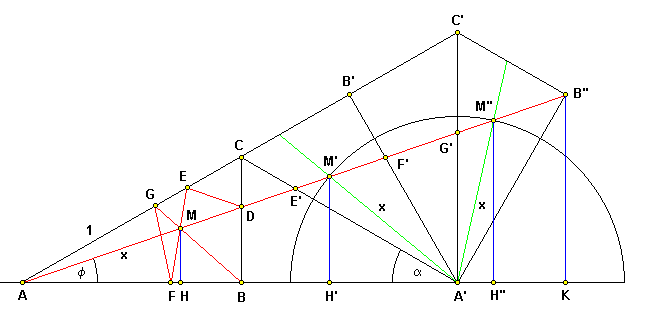LAST EDITED ON Jul-28-03 AT 09:45 PM (EST)
The problem is easily solved by straightening the ball path ADEFGB into a line by tiling the triangle billiard tables:
Let's denote the table angle BAC as a and the initial ball angle BAD as f and let's select the table hypotenuse AC as the unit length. Coordinates of the endpoint B" of the straightened ball path ADE'F'G'B" are
B" º { cosa (2 cosa - cosa cos4a), cosa sin4a }
Tangent of the ball angle f is then
tanf = sin4a / (2 - cos4a)
Note that if p/2 < 4a < p (as in the above drawing), then 0 < p - 4a < p/2
sin(p - 4a) > 0
cos(p - 4a) > 0
sin(p - 4a) = sinp cos4a - cosp sin4a = sin4a
cos(p - 4a) = cosp cos4a + sinp sin4a = -cos4a
The upper limit for the billiard table angle a is
sin4a > 0
4a < p
a < p/4 (45°)
The lower limit is given by the expression
tana > sin4a / (2 - cos4a)
a > ~24.7°
If the table angle is out of these limits, the ball can never reach the point B, not to mention any path concurrence.
Since the ball paths AD, EF, and GB are concurrent - they intersect at the point M, the images M' and M" of this point are on the line AB" and at distance x = AM = A'M' = A'M" from the point A'. Coordinates of the points M' and M" are
M' º { 2 cosa - x cos(2a - f), x sin(2a - f) }
M" º { 2 cosa - x cos(4a - f), x sin(4a - f) }
As the right angle trianlges DABD, DAHM, DAH'M', and DAH"M" are all similar, we have
tanf = x sin(2a - f) / (2 cosa - x cos(2a - f))
tanf = x sin(4a - f) / (2 cosa - x cos(4a - f))
Solving both equations for x
x = 2 cosa tanf / (sin(2a - f) + tanf cos(2a - f))
x = 2 cosa tanf / (sin(4a - f) + tanf cos(4a - f))
x = 2 cosa sinf / (cosf sin(2a - f) + sinf cos(2a - f))
x = 2 cosa sinf / (cosf sin(4a - f) + sinf cos(4a - f))
x = 2 cosa sinf / sin2a
x = 2 cosa sinf / sin4a
Combining the 2 equations
2 cosa sinf / sin2a = 2 cosa sinf / sin4a
sin4a = sin2a
Within the limits for the table angle 24.7° < a < 45° (even within wider and simpler limits 0° < a < 45°), this is only possible if
4a = p - 2a
a = p/6 (30°)
Using the tangent of the initial ball angle f deduced from the coordinates of the path endpoint B"
4a = 2p/3
tanf = sin4a / (2 - cos4a) = sin(2p/3)/(2 - cos(2p/3)) = (Ö3/2) / (2 + 1/2) = Ö3/5
f ~ 19.1°
I have no idea why the following expression has any importance, did not have to use a single square in the solution.
75 (tan2a - tan2f) = 75 ((Ö3/3)2 - (Ö3/5)2) = 75 (1/3 - 3/25) = 25 - 9 = 16